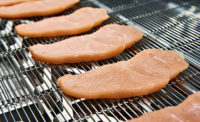For those very reasons, Thrushwood Farms Quality Meats Inc., Galesburg, Ill., recently purchased three three-truck smokehouses with increasing efficiency top-of-mind. Thrushwood Farms put a high priority on the microprocessor that runs the house and how that processor will make the house more efficient.
“Smokehouses are an area in the meat industry that we feel will be further emphasized and looked at by FSIS,” says Doug Hankes, the company’s vice president of operations. “That is why we were very specific in the requirements that we had.”
Kevin Western, president of Western’s Smokehouse, Greentop, Mo., agrees that increased regulations for processors make technology a tremendous aid, especially to smaller processors. Although some technologies may not be new, such as electronic humidity control, they are being used more.
“That in itself is going to allow a lot of small processors to continue to survive,” Western says. “Technology is going to aid the small processor to continue to do business as they are used to doing business.”
Western also believes that it is important for processors to use the technology that they may own already in-house in addition to retrofitting older equipment with new technology.
“There are a lot of companies who are making controls that can actually monitor the processes that can help with the regulatory side of things,” Western explains. “That’s where I see the technology that’s in place now, and I can see a need in the future, because of the magnifying glass that we’re under with regulatory. We’re going to have to be able to prove that our processes are working. We are going to be able to do that way more efficiently with the technology that these [smokehouses] have on them.”
Improved technologies
Technological efficiencies, particularly in the areas of energy, employee and smoke usage, were key areas of importance to Thrushwood Farms now and for future. The company wanted a heavily insulated smokehouse that also was designed to be efficient in power while still providing great airflow. In addition, the processor believed airflow was absolutely crucial to ensure even cooking and product uniformity. When the processor was looking for smokehouses, flexibility in how air moves and flows throughout the smokehouse was also an important innovation for the equipment to have.
Improved airflow technology is what sold Western’s Smokehouse on a new smokehouse it recently purchased.
“It’s high airflow — relatively little use of airflow through damper control,” Western says. “I think if these companies want to continue to innovate they would continue to work on their airflow mechanism.”
Microprocessors also allow Thrushwood Farms to monitor the smokehouses remotely so it can be more efficient and confirm that when product is done, the processor can immediately push those products into the cooler and guarantee proper chilling.
“Additionally, the microprocessor will allow us to monitor and record humidity, temperature, smoke levels and fan speed,” Hankes says. Thrushwood Farms even retrofitted its older smokehouses with microprocessors.
“It allows us to build programs that will ensure our ability to meet the requirements of FSIS and our customers,” Hankes says. He believes microprocessors are the future for smokehouses.
“Ten years ago, you wouldn’t have thought about checking the smokehouses on your smartphone at night or during the day, and now you can remotely monitor,” he says. “They can take snapshots of where the airflow is in the smokehouse. We can do things like monitor and control our humidity better, our ability to dry or cook with moisture heat. We can control the amount of smoke in the smokehouses, so we can provide different tastes and colors.
“Then from a financial side, minimize our losses through that uniform climate is really, really important to us,” Hankes adds. Greater technology also requires less manpower, but more knowledge.
“Where the real growth is for the meat processor, and I really believe what is going to be required of them, is more knowledge,” Hankes says. “What is your smokehouse actually doing? How do you monitor it? How do you track it, and then how can you create data points from that so you can make better decisions in terms what’s happening in that house and how you make products?”
As a small processor growing into larger ovens, Hankes says, Thrushwood Farms’ ability to cook more product in one smokehouse is imperative. Furthermore, Thrushwood Farms believes pass-through smokehouses — in one side of the smokehouse raw and out the other side cooked — to be crucial, and the company’s HACCP plan was designed around those principles. More common in larger plants, these pass-through systems are becoming more popular with smaller processors too.
“I think down the road, we’ll see a day where it goes in one side raw and it comes out another side of the smokehouse cooked and into separate parts of the plant,” he says. “We designed our whole plant around our ability to cook. We wanted raw product to be a continuous flow. The product gets cooked in a sealed smokehouse. It goes into a different part of the plant as a cooked product, and therefore it’s handled separately.”
Down the road, Thrushwood Farms also expects to see some changes in smokehouse cleaning.
“All of our new smokehouses come with a built-in cleaning system, and so that will allow us hopefully a lot of cost savings,” Hankes says. “I think you are going to see more advanced cleaning systems in the future too.”
One additional area where Hankes would like to see more advancement is in the design of the smoke trucks and tailoring smoke trucks to the products.




Report Abusive Comment